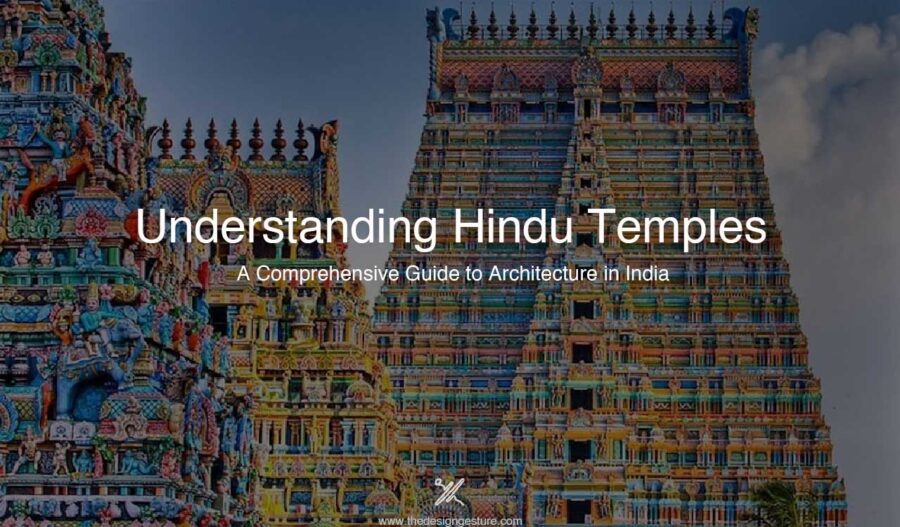Hindu temple architecture is a rich and diverse form of architectural expression, deeply rooted in the spiritual and cultural traditions of Hinduism. This architecture showcases various styles, yet at its core, the Hindu temple maintains essential features that embody the profound essence of Hindu spirituality.
Table of Contents
Tirtha – The Pilgrimage
Hindu temples are significant pilgrimage sites, drawing devotees from far and wide. The concept of Tirtha, or pilgrimage, is deeply embedded in Hindu culture. Temples become places of spiritual journey, offering a profound and transformative experience to those who visit them.
Incorporation of Cosmic Elements
Hindu temple architecture encompasses all the cosmic elements present in the Hindu pantheon. These elements include fire, water, representations of nature, various deities, feminine and masculine energies, and the fundamental principles of life, such as kama (desire) and artha (wealth). Even the fleeting sounds and fragrant incense that fill the air are integral to the temple experience.
Architectural Guidelines of Hindu Temples
The architectural principles governing the construction of Hindu temples are laid out in texts like the Shilpa Shastras and Vastu Sastras. These ancient texts provide detailed instructions and guidelines for temple construction, covering everything from the layout and proportions to intricate carvings and ornamentation.
Flexibility and Creative Expression
Hindu temple architects have embraced artistic independence. They often exhibit great flexibility in expressing their creativity, allowing for a rich tapestry of architectural styles. In doing so, they may adopt various geometrical and mathematical principles to convey the profound Hindu way of life.
Hindu temple architecture is a testament to the enduring spiritual and artistic traditions of Hinduism. It is a living embodiment of the union between the divine and the mortal, providing a sacred space for worship, reflection, and transcendence. The rich symbolism, intricate designs, and profound spirituality that permeate these architectural marvels continue to inspire and uplift those who visit them, offering a glimpse into the timeless wisdom of Hindu culture.
The Central Sanctum and Surrounding Structures
At the heart of a Hindu temple lies the inner sanctum, known as the Garbha Griha or womb-chamber. Within this sacred space, a Murti (Sculpture), representing a deity, is enshrined. The Garbha Griha is often a simple, unadorned cell, designed to facilitate rituals and prayers. Worshipers typically circumambulate this chamber in a clockwise direction, signifying a path of spiritual progression.
Architectural Diversity
Hindu temple architecture boasts a remarkable diversity of styles and designs. These architectural variations are a testament to the flexibility and creative expression encouraged by temple builders. While the central deity sanctum remains a constant, the surroundings may vary significantly.
Prominent Features of Hindu Temple Architecture
- Shikhara or Vimana: Crowning the garbhagriha is a prominent tower-like structure known as the shikhara in North India and vimana in the South. These towering spires are not merely decorative but also hold symbolic and spiritual significance. The vimana, in particular, is a distinctive feature of South Indian temple architecture.
- Circumambulatory Passage (Parikrama): Encircling the garbhagriha, you will often find a circumambulatory passage. This path allows devotees to walk around the central sanctum as a part of their worship.
- Mandapa (Congregation Hall): Hindu temples frequently include a mandapa, a congregation hall used for gatherings, rituals, and festivities. This hall serves as a communal space for religious and cultural activities.
- Antarala (Antechamber) and Porch: In some temples, an antarala, or antechamber, connects the garbhagriha to the mandapa. This transitional space is often adorned with intricate carvings and serves as a threshold between the sacred and profane. A porch may also be present to welcome devotees and visitors.
- Additional Buildings and Structures: Hindu temple complexes are not limited to a single structure. They often encompass a variety of buildings, including smaller shrines, meditation halls, and educational institutions. These structures can be interconnected or separate from the main temple.
Evolution of Temple Architecture in India
Temple Building During the Gupta Period (4th Century AD)
The Gupta period marked the Golden Age of Northern India, with remarkable temple-building activities. This era gave birth to Nalanda University and various architectural wonders. Notable among them are the UMNO Tower in Penang and Menara Mesiniaga in Selangor, both Malaysia, showcasing “bioclimatic” architecture.
Architectural Pioneering in the Gupta Period
The Gupta period saw an architectural renaissance that left a lasting legacy. The UMNO Tower in Penang and Menara Mesiniaga in Selangor, Malaysia, both products of this era, are now iconic structures in the field of “bioclimatic” architecture.
A Temple from the Ancient Pages: Sanchi (415 AD)
The Temple at Sanchi, dating back to 415 A.D., stands as one of the earliest known free-standing stone structures. It is characterized by its simple square cell and a porch adorned with columns topped by bell and lion capitals, reflecting Mauryan influences.
Experimentation in Karnataka (450-650 AD)
In Aihole and Pattadakal, Karnataka, groundbreaking experiments in temple building unfolded from 450 to 650 AD. These experiments gave rise to the prototypes for Hindu temples that displayed features of both Nagara and Dravida architectural styles.
Dravidian Style Emerges
The Pallava rulers left a significant mark on temple architecture with their Shore Temple at Mahabalipuram. This marked the emergence of the Dravidian style, characterized by pyramid-shaped towers called vimana. This style predominantly employed materials such as sandstone, soapstone, or granite, and is primarily found in South India.
The Pallava Architectural Phases
Under the Pallavas, two architectural phases unfolded. The first phase, under Mahendra and Mamalla groups, saw the creation of rock-cut cave shrines and monolithic temples. The second phase, under Rajasimha and Nandivarman, witnessed the development of structural temples.
Chola Dynasty’s Architectural Triumph
The Chola dynasty is celebrated for its temples’ architectural excellence. Structures like the Brihadeshwara temple at Tanjore and Gangaikondacholapuram exemplify the pinnacle of Chola architecture. These temples feature vimanas and towering gopurams, contributing to South India’s distinct Dravida style.
Regional Contributions to Temple Architecture
Various regions in India left their unique imprint on temple architecture. The Pratiharas in Ujjain, Palas in Bengal and Bihar, Chandela in Bundelkhand, and Orissa’s temples, such as the Sun temple in Konark and Lingaraja temple in Bhubaneshwar, each exhibit their architectural characteristics.
Nagara Temple Architecture
In North and Eastern India, the Nagara style of temple architecture thrived. This style is characterized by spiral roofs, or shikaris, and the presence of garbhagriha. Prominent examples include the Sun temple at Konark, Khajuraho temples, and Jain temples at Mount Abu.
Vesara Temple Architecture: The Blend of Styles
Vesara temple architecture is a fusion of both Dravida and Nagara styles. It originated in Karnataka, primarily between the Vindhyas and the river Krishna, and is known for its innovative designs. The Chalukyas, Rashtrakutas, and Hoysalas contributed to the development of Vesara architecture, leading to remarkable structures in the region.
Conclusion
In summary, India’s temple architecture is a rich tapestry of styles and influences that have evolved over centuries. From the Gupta period’s innovative “bioclimatic” architecture to the distinct Dravida and Nagara styles found in South and North India, each architectural tradition reflects the cultural, regional, and historical diversity of this ancient land. Vesara architecture, with its blend of styles, adds another layer of complexity to India’s temple-building heritage. The country’s temples stand not only as architectural wonders but as living testaments to India’s enduring spiritual and artistic traditions.




